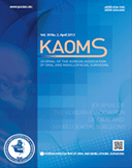Journal of the Korean Association of Oral and Maxillofacial Surgeons
- P-ISSN2234-7550
- E-ISSN2234-5930
- SCOPUS, KCI, ESCI
 ISSN : 2234-7550
ISSN : 2234-7550
하악 과두 골절에 대한 4년간의 후향적 임상연구
A retrospective clinical study of condylar fractures of the mandible in a 4-year period
김현섭 (전남대학교)
박충열 (전남대학교)
국민석 (전남대학교)
박홍주 (전남대학교)
오희균 (전남대학교)
Abstract
The present study was performed to evaluate the function of the mandible according to the pattern of fracture and treatment methods of condylar fractures of the mandible and help operators in making a treatment plan. Sixty patients (average follow-up period was 7.8±9.4 months) who were treated for condylar fracture from June, 2002 to May, 2006 at the Department of Oral and Maxillofacial surgery, Chonnam National University Hospital were reviewed. The common causes of the condylar fracture were traffic accident and fall-down (35.0%). In concomitant injuries, laceration was 46.7% and the fracture of the mandibular symphysis was highest incidence (60.0%). The common site of the fracture was the condylar head (47.8%), followed by subcondyle (36.2%) and condylar neck (15.9%). Under 15 years old patients, the closed reduction was performed in 87.5% out of the patients. All of the condylar fragments were fixed to the mandible with titanium miniplates in cases of open reduction. The mean period of intermaxillary fixation (IMF) was 14.2±6.5 days in closed reduction and 10.0±4.2 days in open reduction. The old patient with bilateral condylar head fractures, who were treated by closed reduction with IMF for 3 weeks, showed the limitation of mandibular movements. But, there was no significant different results between open reduction and closed reduction with the respect of the Helkimo's mandibular mobility index and clinical dysfunction index (DI). Complications, such as fibrous ankylosis and resorption of the mandibular condyle, were not observed in all patients. These results suggest that the good results can be obtained by closed reduction with proper IMF periods and functional exercise in most condylar fractures of the mandible except severely displaced extracapsular fractures.
- keywords
- Condylar fracture, Closed reduction, Open reduction
- 다운로드 수
- 조회수
- 0KCI 피인용수
- 0WOS 피인용수